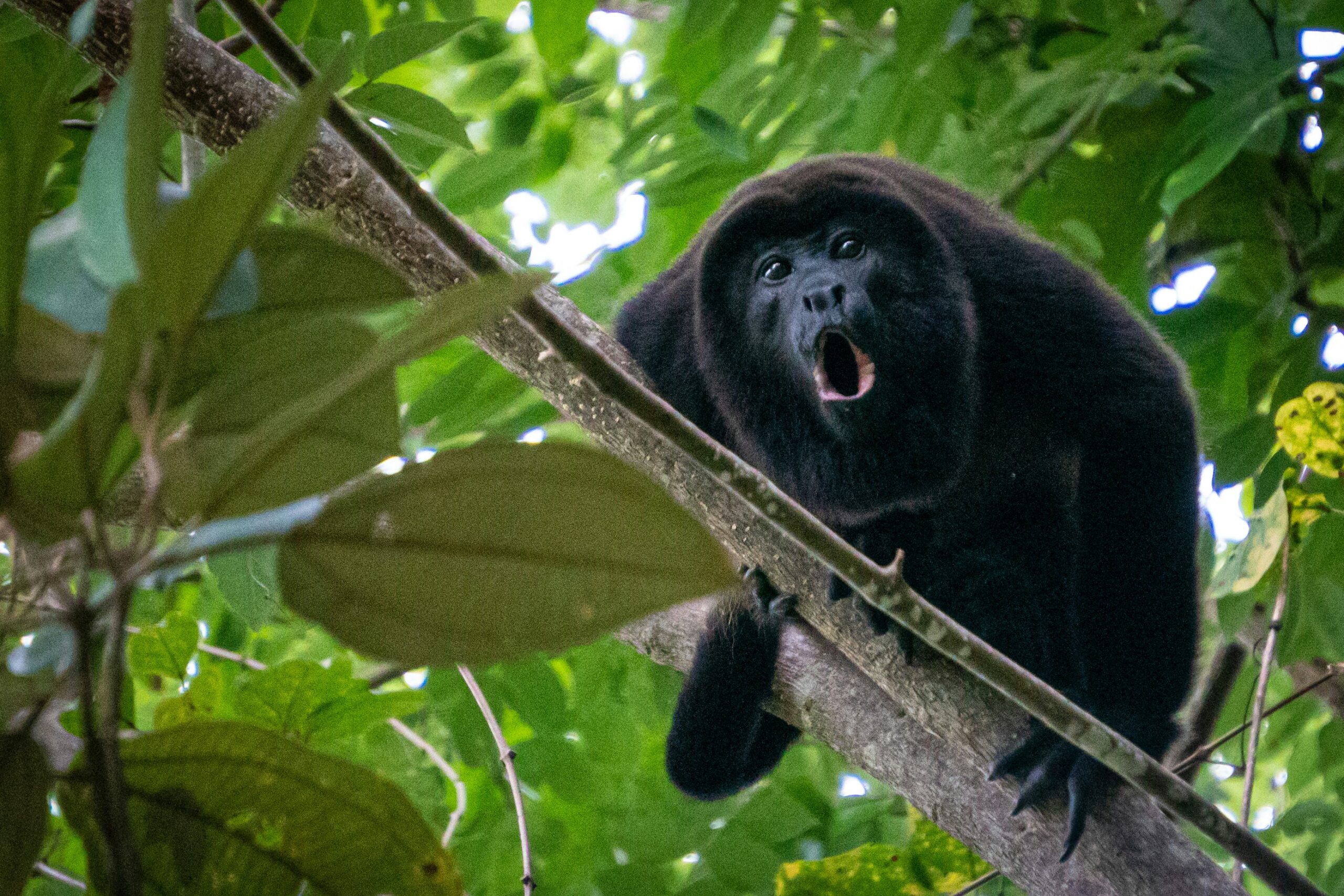The southernmost state
Chiapas, the southernmost state in Mexico, is celebrated for its rich cultural heritage, diverse ecosystems and world renowned historical sites. It is bordered by Oaxaca state to the west, Veracruz to the northwest and Tabasco to the north. To the east and southeast it borders Guatemala, whilst the state’s southwest has a coastline on the Pacific Ocean. With its natural geography of rivers, highlands and mountains, Chiapas boasts miles of tropical rainforests and cloud forests. Although deforestation at the hands of agriculture, logging, and infrastructure development continues to be a major issue, the state is still one of the most biodiverse in Mexico and forms part of the Mesoamerican Biological Corridor.
Our destination in Chiapas is Palenque, a name shared by both a modern town and the world renowned UNESCO Mayan archaeological site. Arriving by bus following time spent in Quintana Roo, Yucatan and Campeche, the landscape changes dramatically. From lowland mangrove swamps and stretching grasslands, to winding roads of the Sierra Madre foothills, looking out over miles of dense rainforest, travelling through Mexico by bus allows the country’s dramatic scenery to be fully appreciated.
We’re staying at Cabañas Kin Balam Palenque, one of the area’s many eco-resorts on the stretch of forested road between Palenque town and the archeological site. Situated at the edge of Palenque National Park, itself a part of the mighty Lacandón jungle, Cabañas Kin Balam Palenque is based around low impact, rustic accommodation. Like most of the eco-resorts in this area, there’s the options of camping, small private cabañas and larger shared cabaña dorms.
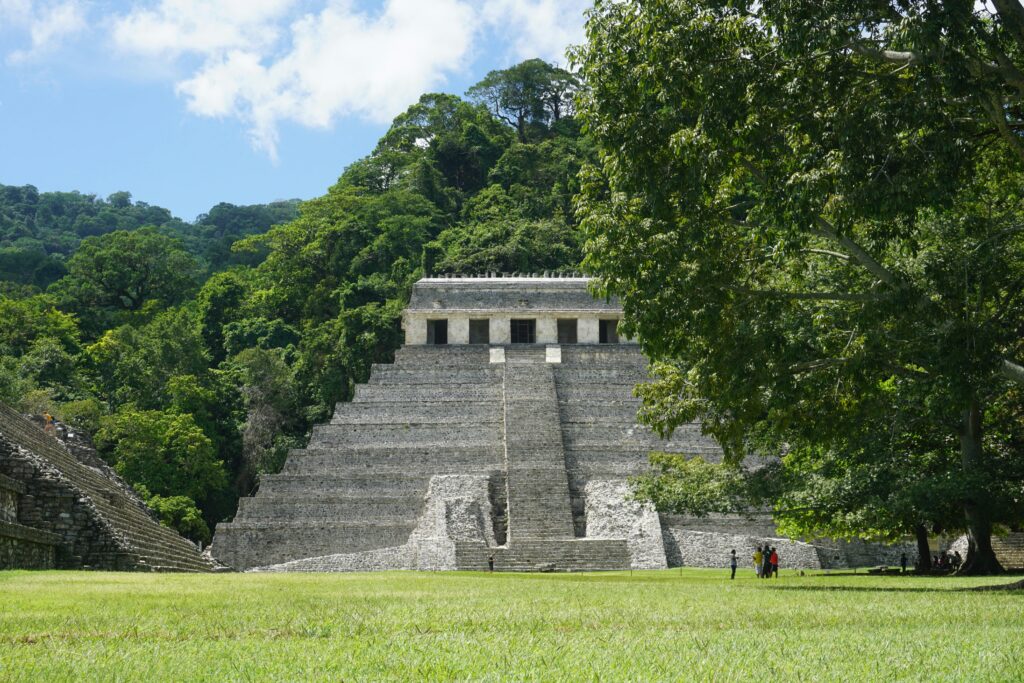
Nature at dusk and dawn
Taking a collectivo from Palenque bus station, we arrive at our accommodation after sunset. Down a small trail there’s a dim light piercing the distant dark, giving a soft glow to well-worn wooden handrails, mosaiced brick walls and the overhanging tree canopies. Whilst waiting for our eyes to adjust to the dark, the biggest sensory stimulus is the sound. A constant percussive thrum, as a different insect trills at every frequency on the spectrum. This place is alive and singing, from the floor to the treetops.
Our cabaña is unfussy and comfortable, a cube of half wood, half mesh walls with curtains, a roof fan and a lamp. The shower block is a nature reserve in itself, as thick clouds of moths form halos on every low lit lamp, whilst many types of geckos wait deathly still for equally unmoving stick insects and katydids, all sharing the same roof underside.
The next morning’s alarm clock is the distant caterwaul of howler monkeys, their name seemingly very apt. Despite the unrequested wake up, exploring the accommodation grounds at sunrise is a moment of magic. Built around a slow flowing stream and set against the rainforest, there’s special areas planted with rare, local plant species. Gently heated by the rising sun, the dew of the cool night lifts from the ground in swirling columns of vapour, catching the sun’s rays, occasionally splitting the beams into hazy rainbows.
A morning stroll sees timid agoutis pawing at the leaf litter in the dappled light, as iridescent hummingbirds dart from one bird-of-paradise flower to the next. Carefree butterflies glide amongst lightning flashes of blue and green dragonflies, whilst the background chatter of toucans plays out from the surrounding forest. As the sun continues to rise, but before it gets too hot, we catch a bus to Palenque and the jungle which envelopes it.
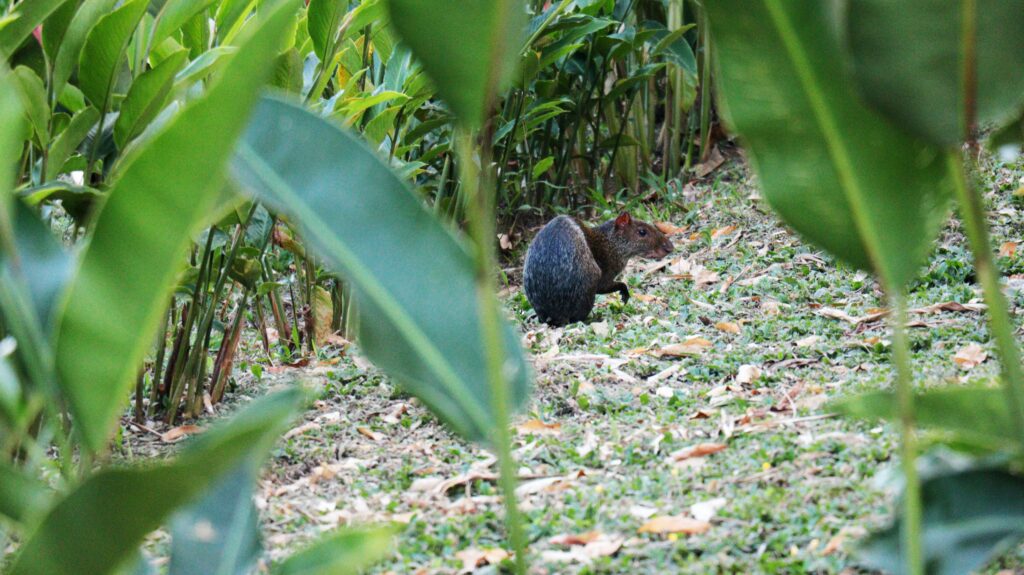
Into the jungle
Arriving at the Palenque archaeological site ticket entrance, we need to purchase two sets of tickets, one for the site itself (75 MX) and another for the entrance into the Palenque National Park (36 MX). Stood around the site entrance is a handful of notably unpushy tour guides who offer both tours of the archaeological site and the surrounding forest, the latter of which they explain is prohibited, since COVID, for visitors to enter without a guide.
We negotiate a price for a tour of the forest only with a woman called Elena, roughly £25 for what will be around 2 hours, she tells us we’ll when we arrive at the forest entrance we’ll also be joined by a man named Miguel, who’s of Chʼol heritage and had a deep, familial connection as well as vast knowledge of the area we were about to explore.
Arriving into the park, the first set of steps right by the entrance are flanked by two large ceiba trees, which in a case of unbelievable good luck, were the current gymnasium for a troupe of howler monkeys. Their small stature belies the sounds they’re able to produce, a family of ten or so monkeys make for good entertainment as they forage, squabble and bellow together in the tree tops. Veering to the treeline to the right of the Temple of the Inscriptions, where Elena introduces us to Miguel and shows us a small hidden footpath, cordoned off by a length of blue rope.
Stepping into the rainforest is setting foot into another world, a hidden world, where 90% of the Palenque site still remains unearthed, where ravenous jungle keeps the bones of the once great Mayan city. Cedar and mahogany trees form a cathedral of green and brown and a thick understory is formed of devil-thorned young ceiba trees and twisting vines which grasp at crumbling ruins.
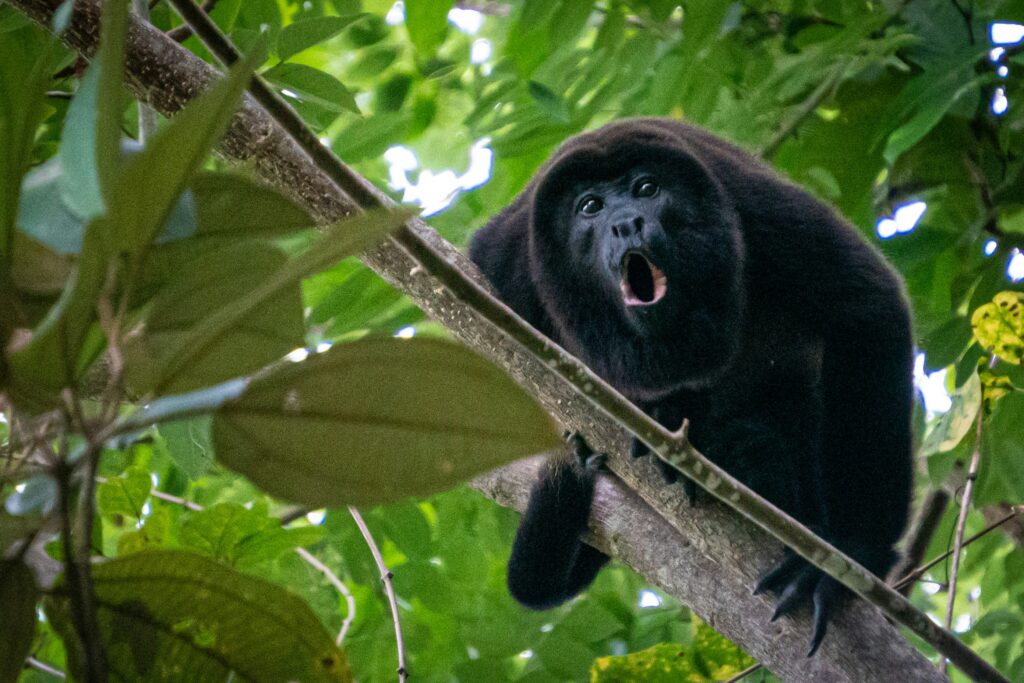
Local knowledge
Between Elena and Miguel, the wealth of knowledge about the forests of Palenque is incredible. Just metres into the treeline, Miguel is offering us to smell crushed leaves which indigenous people have used as pain medication for centuries, flowers which are used as soaps and dyes. We’re warned whilst scrambling up hills and through the undergrowth, to avoid grasping at any trees or branches for fear of clasping a hand on barbed caterpillars and venomous plants. We carefully step over an endless stream of leafcutter ants, working tirelessly to move sections of leaves many times their size.
Further on the forest is stifling, humid and mesmerising, we’re shown the tracks of an armadillo, its footprints either side of upturned soil from where it had rootled for grubs and worms. Miguel shows us a termite mound at least a metre high, with hundreds of white termites pouring out the top. Miguel says they’re edible, as he dips a finger into the stream of insects then into his mouth, describing the taste as both woody and minty.
As Elena guides us through past liana vines and huge buttressed tree trunks, we step over mounds and hills which she explains are the still buried buildings of Palenque, at one point coming across an intact tunnel of ancient brickwork, all needing to crouch down low to walk through. Shuffling past still visible relief carvings, Elena describes the animals sacred to the Maya, she says that there’s still Ocelots in this part of the forest and further to the north, Jaguars still roam.
After observing a cluster of recluse spiders on the stepping stones of a rushing stream, we cool our hands and foreheads with the crystal water. Our trek is nearing an end, as we start to say goodbye Miguel spots something high up in the canopy, a solitary ruby jewel perched in a sea of emerald. In a bittersweet moment, as Miguel says it’s most likely a collared trogon, a close relative to the fabled resplendent quetzal so revered by the Mayans. He’s never seen a Quetzal in this part of Chiapas, his ancestral home for many generations of Ch’ol, going on to explain that with them being so endangered, he fears he never will.
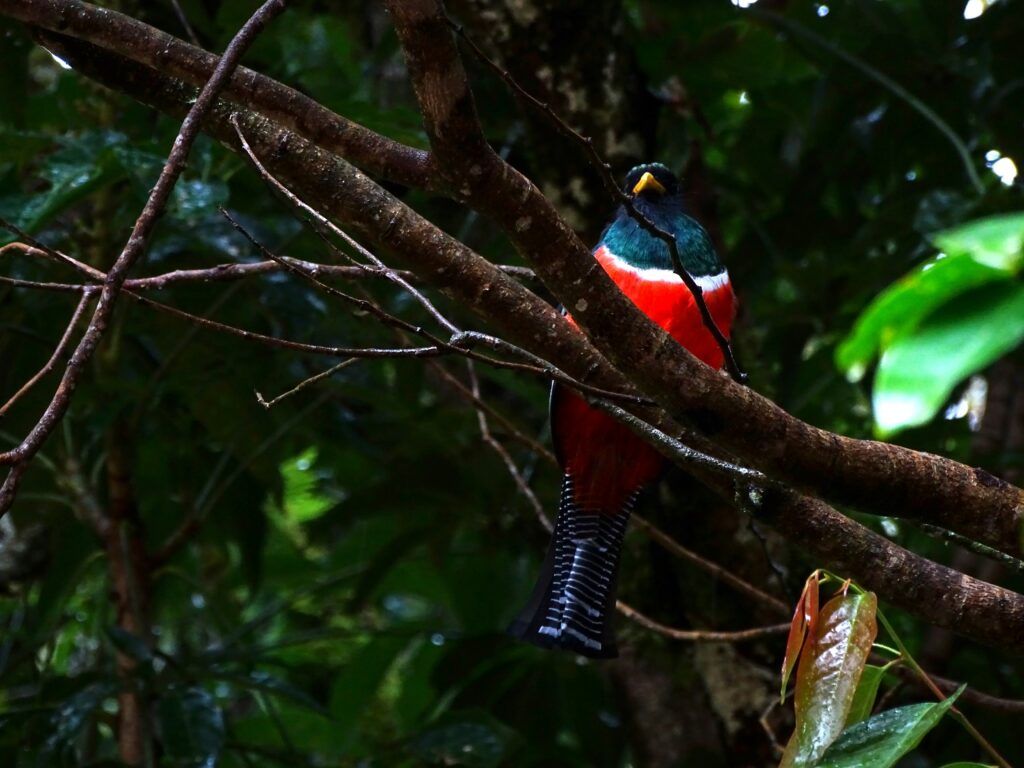
Back Into The Word
As we emerge back into the Palenque archaeological site, Elena feels it would be remiss to not give us at least some knowledge of the ruins. She explains back in the height of the city, all the now exposed stone work would have been covered in a thick stucco, painted bright red. The agreed historic account for the abandonment of Palenque includes many reasons, workers and artisans moving to coastal locations for better job opportunities, failing crops and aridification.
Elena says one of the main reasons was the changing climate, a change that even in the 9th century, was brought on by man. She explains that the process to create the massive amounts of stucco to cover the buildings, a vast amount of firewood was needed. That the rulers of Palenque desired above all the beauty of the city, that the burning of the forest was an acceptable price to pay. So far did the deforestation go on surrounding the city, the rainforest microclimate changed and the rains began to no longer fall on Palenque, drought, leading to famine and then disease were what followed.
Whether Elena’s account holds up to academic inspection remains to be seen, but it’s a cautionary tale as relevant now than ever. The flipside to the coin of man made desolation of the forests surrounding the ancient city of Palenque, is that now the forest has reclaimed it all. Only around 10% of the former city has been cleared and maintained, the rest is just too vast to clear and the ongoing fight against the jungle is deemed unwinnable. This decision is of course now fortified with a desire for conservation and ecological protection, that we must protect the fragile nature which is there. The jungles of Palenque are the perfect place to discover the flora and fauna of Chiapas and to witness first hand, the incredible power of mother nature to take back what is hers.

